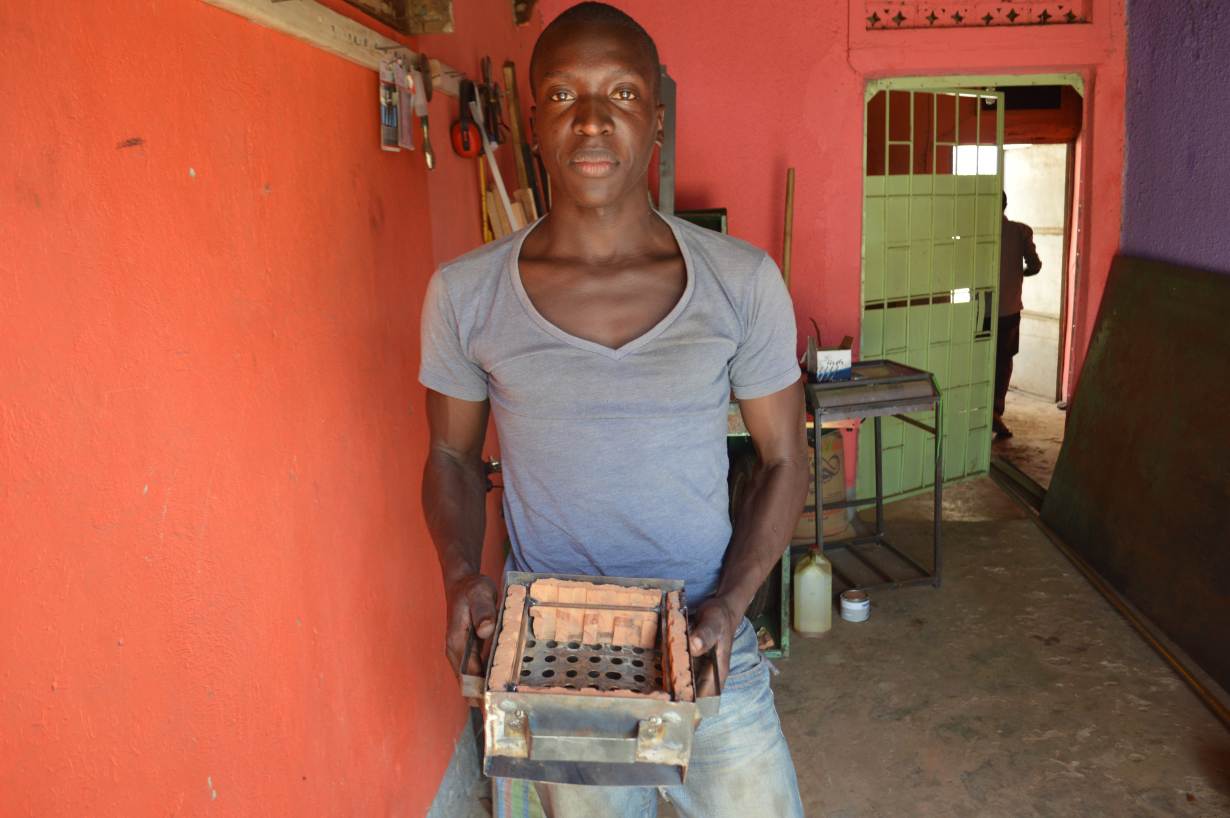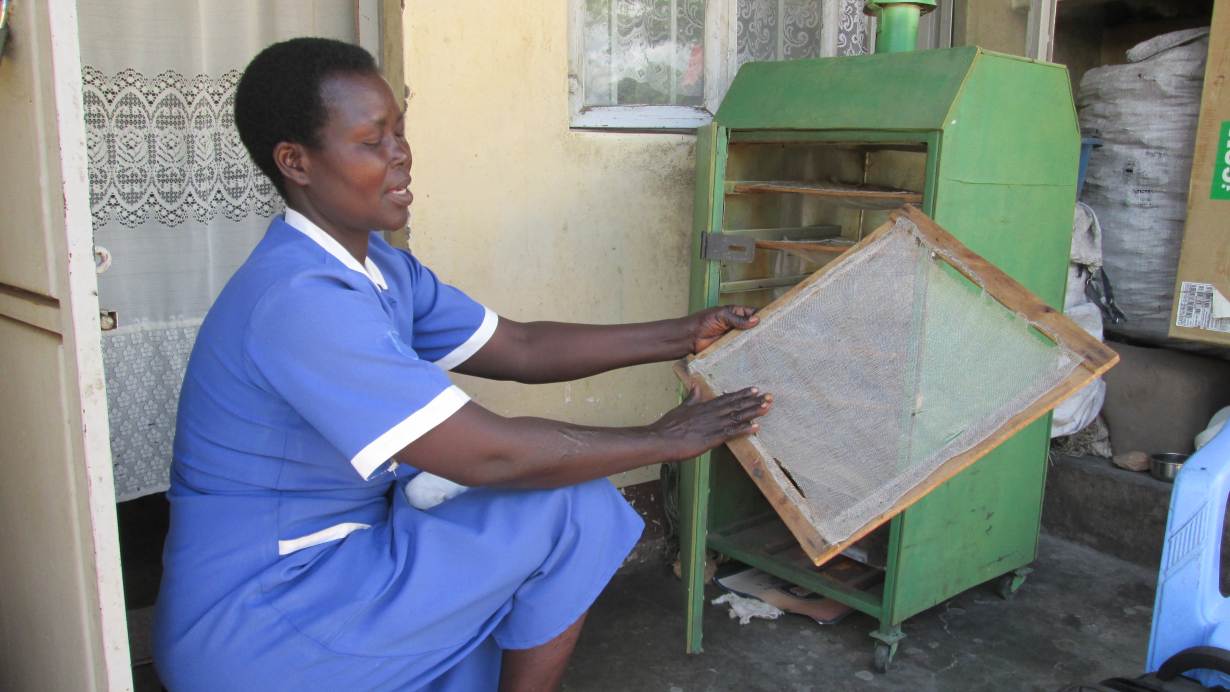Ugandan entrepreneurs cook up low-tech, eco-friendly dryer to cut food waste
The affordable machine to dry fruit and vegetables helps farmers stop harvests spoiling and burns green briquettes, not charcoal, for heat
K
AMPALA, July 28 (Thomson Reuters Foundation) – At their workshop in a Kampala suburb, Lawrence Okettayot and his business partner, both in their mid-20s, drilled holes and screws into a steel-lined, green wooden box designed to dry food in an eco-friendly way.
Their invention, a low-tech thermal dehydrator, can be used to process fruits like mango, banana and pineapple, as well as vegetables such as okra and eggplant, to stop them spoiling.
It uses heat from briquettes made of discarded paper and other natural materials, including garden waste.
Food waste is a big challenge in Africa, with about half of crops lost due to poor harvesting techniques and handling afterwards, according to the U.N. Food and Agriculture Organization.
Okettayot had a light-bulb moment in 2016 when his uncle decided to quit farming out of frustration over his produce going to waste because he could not find a ready market.
Having grown up in northern Uganda, where a two-decade insurgency by the Lord’s Resistance Army (LRA), a brutal rebel group, caused widespread food shortages, Okettayot thought hard about a solution.
After completing their studies in mechanical engineering, he and his childhood friend, Morris Opiyo, embarked on making their first dryer to preserve food. It worked well and was “a good inspiration”, Okettayot said.
Since then, the pair have made 43 dryers and sold them across Uganda, Rwanda, Zimbabwe and Burkina Faso to individual farmers. They now have plans to ship some to Central African Republic and Mauritius.
The “sparky dryer” has a chamber which is lined with steel and insulated with a thick layer of wood to minimise heat loss. A fan on top allows air to flow into the heating chamber so that few briquettes need to be burned to keep it hot.
The heat is transferred to the drying zone where the sliced foodstuff is stacked on shelves.
A catalytic converter also prevents harmful gases from escaping, reducing toxic by-products like carbon monoxide from the smoke-free briquettes and enabling the dryer to operate with zero planet-warming emissions.
Two kilogrammes (4.4 lb) of briquettes are needed to dry 10 kg of mangoes in five hours.

Morris Opiyo shows off a stove that uses eco-friendly briquettes or garden waste to produce heat in Kampala, Uganda, May 13, 2019. Thomson Reuters Foundation/John Okot
CASH-STRAPPED GOVERNMENT
In Uganda alone, 30 percent of crops are lost every year after harvest, with fruits and grains most affected, said Solomon Kalema, a spokesman for the Ministry of Agriculture.
The East African country has few food processing hubs, but Kalema said government plans to install them at a regional level had not been implemented due to limited funds.
In most cases, Ugandan farmers prefer to sun-dry their leafy vegetables, as they contain little moisture and are quick to dry, he noted.
But fruits take longer out in the open, especially in the wet season, so most farmers end up leaving them to rot.
“This affects the quality of commodities and also farmers’ earnings,” Kalema said.
The government relies on extension workers to train farmers to keep their produce in good condition, but the number of agents is stretched thin due to financial constraints, he added.
In 2010, Uganda had one extension worker per 1,000 farmers but now each agent must serve 15,000.
Samalie Namukose, a principle nutritionist at the Ministry of Health, believes the government should invest in cheaper dryers, like those made by Okettayot, to support local farmers.
“It’s something new to many, and there is need for more publicity about it,” she told the Thomson Reuters Foundation.
In general, food dryers – which are mostly solar-powered – are expensive and beyond the means of low-earning farmers, even though they are cost-effective, she said.
On the Ugandan market, a typical small solar-powered dryer costs more than 2 million Ugandan shillings ($542), while a large model can top 9 million shillings.
But Okettayot is aiming for something more affordable – his small dryers are priced at 450,000 shillings each and a big one is double that.
NO CHARCOAL
The machine claims to be eco-friendly, partly because it does not make heat from charcoal, the most common source of energy in Uganda, with 90 percent of the population still using it for cooking.
Pader district in northern Uganda, where Okettayot’s home town is located, has become a hub for commercial charcoal production, which is made by smouldering wood.
The fuel has an environmental cost, contributing to Uganda’s 63% loss of forest cover in the last 25 years, according to the National Forestry Authority.
Okettayot and Opiyo hope their dryers can help protect forests by offering an alternative.
The briquettes they use are made of waste paper and other materials, including fruit peel, sawdust and clay soil. The ingredients are mixed with water and moulded into balls, then dried to make the briquettes.
The dryers also heat up more slowly than with charcoal, reducing the risk of burning food, Opiyo said.

Nurse and farmer Christine Anek explains how she uses her eco-friendly food dryer in Pader district, northern Uganda, May 21, 2019. Thomson Reuters Foundation/John Okot
CLUBBING TOGETHER
Christine Anek, a Pader resident, was trained by Okettayot to make briquettes from garden waste at an outreach session.
The farmer, also a nurse, now sells dried fruit snacks to supplement her daily income.
Okettayot and Opiyo are planning to fight food waste at the village level through a system to help farmers afford a dryer.
Farmers will form into groups and receive a unit on credit, paying for it in instalments.
But before the pair can really expand their business, they need more skilled labour.
“Our goal is to open up an academy where we can train many youths, but this will require time and preparation,” Okettayot said.
($1 = 3,690.0000 Ugandan shillings)
The ideas presented in this article aim to inspire adaptation action – they are the views of the author and do not necessarily reflect those of the Global Center on Adaptation.